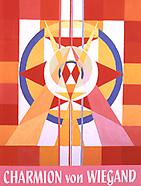Spirituality in Abstraction features a selection of paintings, collages and works on paper dating from 1945 to 1969. A modernist committed to abstraction, Charmion von Wiegand drew inspiration from eastern philosophies and alternative religions. In the catalogue essay which accompanies this exhibition, Dr. Jennifer Newton Hersh states: "Von Wiegand’s mature works reflect her core beliefs: the universe is a single living substance; life is the expression of a dialectic process based on opposites; the goal of living is to achieve oneness; and reality is reached by progressing through stages toward higher states of consciousness."
Charmion von Wiegand, born in Chicago in 1896, spent her early years in San Francisco where her father was a senior correspondent and editor for Hearst newspapers. Throughout her youth, she traveled extensively, studying abroad and learning several European languages. By the mid-1920s, von Wiegand was living in New York City, where she studied at Barnard College before enrolling in Columbia University’s School of Journalism. Motivated by her experience with psychoanalysis in 1926, von Wiegand began to paint in a traditional manner although she did not regard herself as a professional artist until the 1940s, when she embraced abstraction. In 1929, she moved to Russia and worked as the only female foreign correspondent for Hearst newspapers. Upon returning to New York City in 1932, she married journalist Joseph Freeman, editor and co-founder of New Masses. As part of the cultural avant-garde in New York, von Wiegand developed a close circle of acquaintances that included artists John Graham, Jean Hélion, Carl Holty, Frederick Kiesler, Mark Tobey and Joseph Stella.
In 1941, von Wiegand met and interviewed the great Dutch modernist Piet Mondrian who encouraged her to abandon writing in pursuit of a career as a visual artist. That same year, she joined the American Abstract Artists Group and would later serve as its president from 1951 to 1953. During the early 1940s, von Wiegand forged a strong bond with Mondrian and translated his essays into English while pursuing her own artistic career. Her friendship with Mondrian and their shared idealism were vital to her artistic evolution and her pursuit of the spiritual in abstract painting. However, von Wiegand did not restrict herself to the formal constraints of pure Neoplasticism. Following Mondrian’s death in 1944, von Wiegand became interested in Theosophy and through it Tibetan Buddhism. In the 1960s and 1970s, von Wiegand followed a course of spiritual study in the tradition of Mahayana Buddhism especially as it is practiced in Tibet. While von Wiegand would regard all of her art as spiritual, her work from this period is overtly mystical as many works incorporate metaphysical images and symbols of Tantric Buddhism and the traditions of Chinese astrology. In 1973, The Whitney Museum of American Art mounted Von Wiegand’s first major retrospective exhibition. Subsequent retrospectives were held in 1982 at the Bass Museum of Art in Miami Beach, FL and in 1993 at The Joseloff Gallery, University of Hartford in Hartford, CT. In 1980, she was elected to the American Academy of Arts & Letters. Until her death in 1983, von Wiegand lived and worked in New York City. Von Wiegand is represented in numerous museum collections including the Solomon R. Guggenheim Museum, The Hirshhorn Museum and Sculpture Garden, The Metropolitan Museum of Art, The Museum of Modern Art, New York, and the Whitney Museum of American Art.
Michael Rosenfeld Gallery, LLC is the exclusive representative of the Estate of Charmion von Wiegand.





